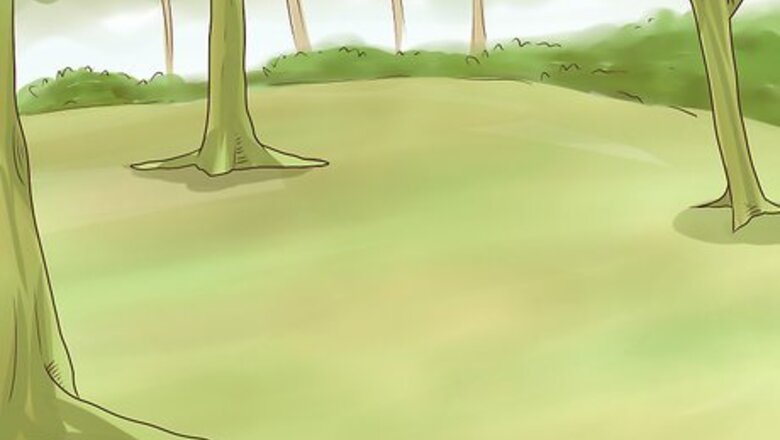
views
Finding the Right Location
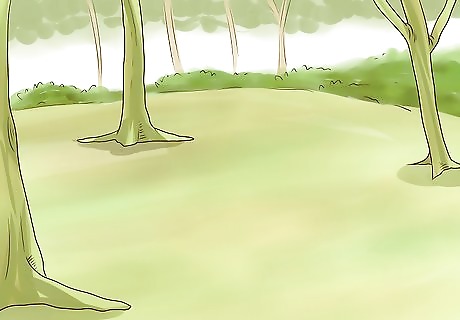
Put your shelter on a dry, flat piece of land. Any moisture on the ground will penetrate through your clothes and make you cold in the night. Feel the ground to see if it’s dry or muddy before settling on a location. A flat spot also ensures that rain won’t run down a slope into your shelter. If you can’t find any flat areas, dig trenches in the ground to divert the water away from where you want to build your shelter.
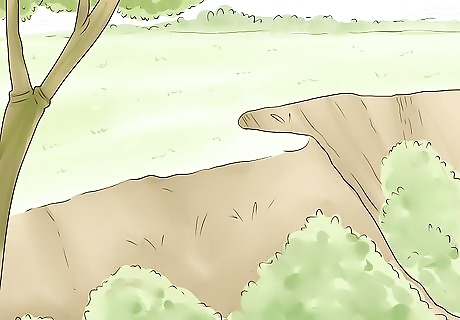
Stay on higher ground away from bodies of water. While you should be a short distance away from a water source, don’t set up your camp next to a river or lake. If it rains or the river floods, you and your shelter could get damp or washed away. Avoid setting your camp in ravines or on low ground for the same reason. Don’t set up in deep valleys since cold air will settle there at night.
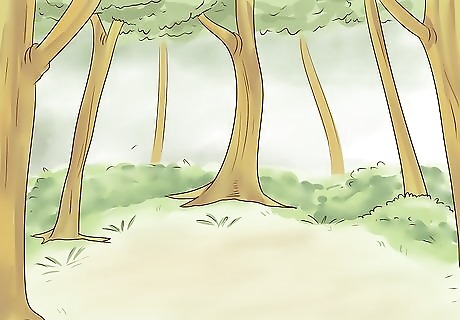
Find an area surrounded by trees to block the wind. If there are cold winds in your area, trees will help buffet them so you can stay warm. Try to find a place with thick foliage to protect yourself from the elements and to stay hidden. If you want to be found, stay close to open areas where you can attract planes flying overhead.
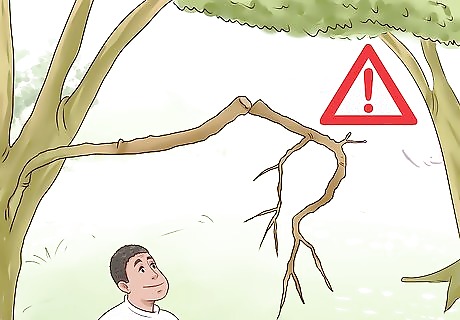
Look above the area for any signs of danger. Check for anything over your head that could cause harm to you or damage your shelter. Look for dead tree limbs, loose rocks, or mud since these could easily break and fall down on top of you.
Constructing a Lean-To
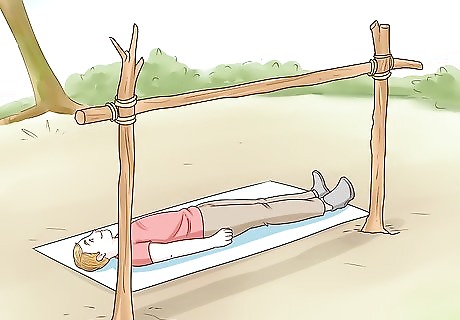
Find a rock or fallen tree to build your lean-to against. Look for an object that’s at least as long as your body. Lie on the ground next to it to see if it’s taller than you to determine if you have space to comfortably spend the night. On top of being the main support for your lean-to, the rock or tree will act as a barrier against the wind and rain. If you can’t find anything that works, prop a long branch on 2 low tree limbs for the main support.

Lean long fallen branches at an angle against the solid surface. Set the branches close together at a 45-degree angle so you have enough space to lie down underneath the shelter. Make sure there aren’t any cracks in between the branches or else wind or rain could easily get inside. Use smaller branches to fill in any holes. For more stability, dig a trench in the ground for a place to rest the ends of the branches.
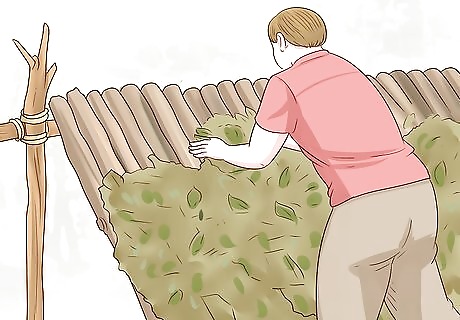
Cover the structure with dead leaves and bark to shield against the elements. Layer the insulation so it’s about 1 ft (0.30 m) thick. This will help fill any smaller cracks and add further protection against the outdoor elements. You may need to walk around a bit to find enough dead leaves and bark to cover the entire structure.
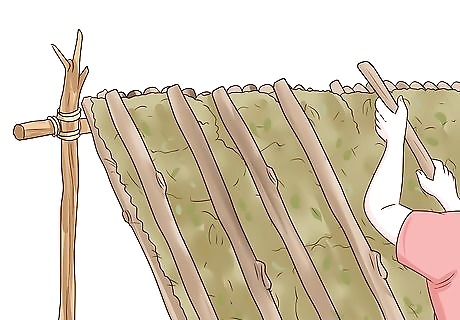
Lay more branches on top of the insulation so it doesn't blow away. Use sturdy, heavy branches that will weigh the insulation down. Keep adding branches until the insulation is completely covered.
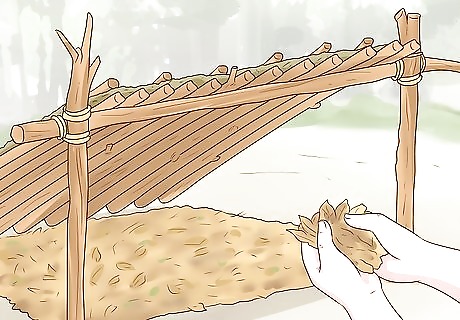
Lay 3–4 in (7.6–10.2 cm) of dead, dry leaves on the ground inside. Collect as much dead foliage as you can and line the ground with it. This will add some comfort to your shelter when you lie down. Avoid using fresh green leaves since you may crush the moisture out of them and get your clothes damp.
Building an A-Frame Shelter
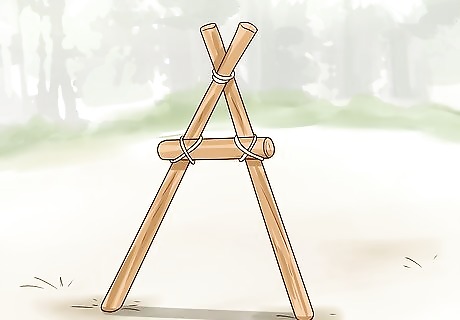
Set up 2 sturdy branches to form an “A” shape. Use branches that are at least 1 ⁄2–2 feet (0.46–0.61 m) in length. Stand them on end and lean them together so their tops meet. Use grass, rope, or your shoelaces to tie them together so the tops form a small "V." You could also find tall logs to use. Set the branches so the opening under the branches faces away from the wind.

Tie a stick that's 2 ft (0.61 m) taller than you to the tops of the A-frame. Make sure the stick is mostly straight. Rest one end in the small "V" at the top of the A-frame and the other end on the ground. Check to see if you have enough room to lie under the shelter completely. Tie the longer branch to the frame so the longer branch doesn’t move around or shift. Dig a small hole to rest the other end of the branch in if you want added stability.
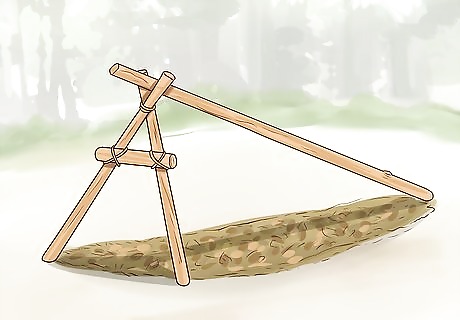
Cover the ground under the structure with dry leaves and grass. Use at least 6–10 in (15–25 cm) of bedding so you aren’t lying on the ground. Avoid using any fresh green leaves since these could easily transfer moisture to your body.
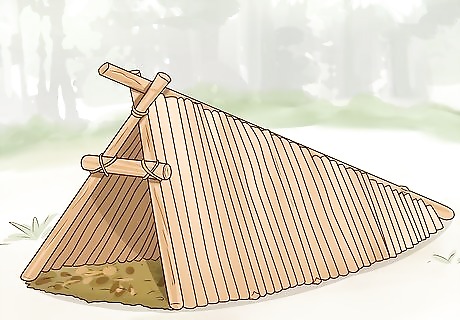
Lean solid branches on each side of the long stick to form a ribcage. Lay the branches on each side of the shelter so they are at a 45-degree angle to the main branch. Break or cut any branches that extend past the long branch so your shelter is compact. Fill in all the cracks between the branches as best as you can. Use smaller branches to cover any holes or cracks and to prevent debris from falling through.

Place dead branches and leaves on top of the ribcage. Start from the bottom of the structure and layer the debris onto the framework you made. The thicker you make your insulation, the warmer you’ll stay and the more camouflaged you’ll be. Aim to layer the leaves at least 2 ft (0.61 m) thick. Cover the opening of your A-frame with more sticks if you want to completely close your shelter when you’re sleeping or away.
Making a Teepee
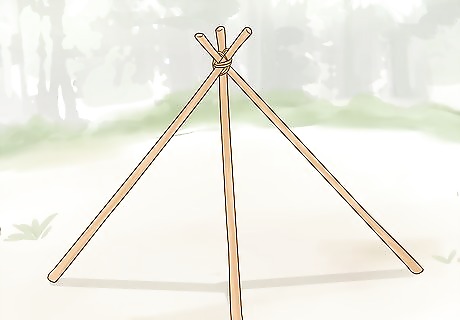
Prop 3 long branches against each other to form a tripod frame. Use branches that are the same length so they’re easier to manage. Tie one end of the branches together with plant fiber, rope, shoelaces, or a belt before standing them upright. Set the branches so they are equal distances apart. The size of the branches depends on how many people you want to fit inside. At the very least, spread the 3 branches far enough apart for you to comfortably lay down. Lean the branches in a circle against a tree trunk if you want extra support.
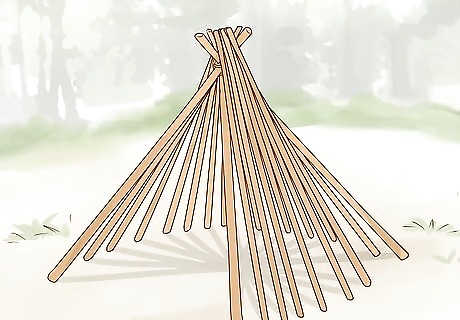
Lean more branches of the same length against the tripod frame. Find more branches that are similar in length to surround the rest of the teepee. When you place one branch, go to the opposite side of the teepee and place another branch so your teepee stays balanced. Remember to leave a gap on one side so you can get in and out of your shelter.
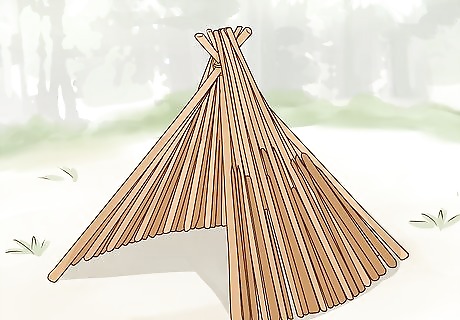
Fill in cracks with smaller branches. Once you have the main structure built, look for any cracks or holes in the frame of your teepee. Use smaller and thinner sticks to fill them in so wind and rain doesn’t get inside of your shelter. Try to cover as many of the cracks as you can.
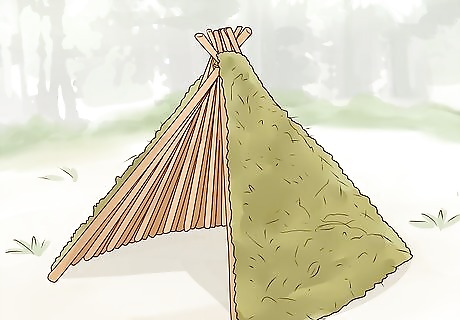
Cover the outside with leafy branches for insulation. Use sturdy branches that have leaves on them to add extra insulation to your teepee. Lean them evenly across the teepee so it is insulated as much as possible. Dead leaves and debris will blow away in strong winds unless you use more branches to hold them in place.

















Comments
0 comment